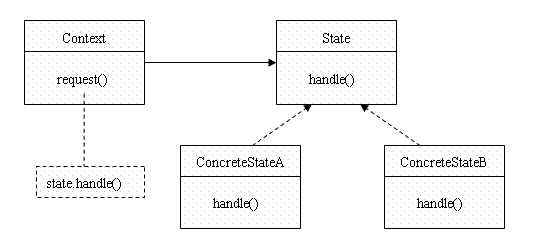标签:
状态模式允许对象内部状态改变时改变它的行为,对象看起来好像修改了它的类。状态模式看起来和策略模式比较相像,策略模式是将可以互换的行为封装起来,然后通过使用委托的方式,决定使用哪一个行为,状态也是封装行为,不同的是可以将行为委托到当前状态。一个需要从外部设置,一个是内部通过状态变更达到行为变成的目的。
状态模式的UML类图:

State封装基本的状态行为,我们通过Cotext上下文持有状态子类的实例,外部发起请求,我们就可以委托状态进行处理。地铁里面一般都有自动饮料售卖机,我们将所有的饮料都当做商品来看,我们如果需要买饮料需要两步,投币,取货,如果没有商品还可以退钱三种行为,关于自动售卖机的存在无钱状态,有钱状态,售卖中状态,已售罄状态四种状态,稍微思考一下,可以看下面的具体实现。
状态行为基类:
@protocol StateProtocol <NSObject> @optional -(void)putMoney; @optional -(void)ejectMoney; @optional -(void)pressButton; @optional -(void)distribute; @end @interface State : NSObject<StateProtocol> @end
售卖机处于无钱状态(NoMoneyState):
@protocol NoMoneyDelegate <NSObject> -(void)setCurrentState:(State *)currentState; -(State *)geHasMoneyState; @end //没钱状态 @interface NoMoneyState : State @property (weak,nonatomic) id<NoMoneyDelegate> delegate; @end
@implementation NoMoneyState
-(void)putMoney{
NSLog(@"NoMoneyState-putMoney:投放钱币");
[self.delegate setCurrentState:[self.delegate geHasMoneyState]];
}
-(void)ejectMoney{
NSLog(@"NoMoneyState-ejectMoney:没有投入钱币,无法退钱");
}
-(void)pressButton{
NSLog(@"NoMoneyState-pressButton:请先投币");
}
-(void)distribute{
NSLog(@"NoMoneyState-pressButton:请投币");
}
@end
售卖机处于有钱状态(HasMoneyState):
@protocol HasMoneyDelegate <NSObject> -(void)setCurrentState:(State *)currentState; -(State *)getNoMoneyState; -(State *)getSoldState; @end //有钱状态 @interface HasMoneyState : State @property (weak,nonatomic) id<HasMoneyDelegate> delegate; @end
@implementation HasMoneyState
-(void)putMoney{
NSLog(@"HasMoneyState-putMoney:已经投入了钱,暂不支持投入");
}
-(void)ejectMoney{
NSLog(@"HasMoneyState-ejectMoney:退钱,重新设置售卖机为无前状态");
[self.delegate setCurrentState:[self.delegate getNoMoneyState]];
}
-(void)pressButton{
NSLog(@"HasMoneyState-pressButton:按钮按下,取货");
[self.delegate setCurrentState:[self.delegate getSoldState]];
}
-(void)distribute{
NSLog(@"HasMoneyState-distribute:无法进行取出商品");
}
@end
售卖机处于售卖状态:
@protocol SoldDelegate <NSObject> -(void)setCurrentState:(State *)currentState; -(void)realseProduct; -(NSInteger)getCurrentCount; -(State *)getNoMoneyState; -(State *)getSoldOutState; @end //售出状态 @interface SoldState : State @property (weak,nonatomic) id<SoldDelegate> delegate; @end
@implementation SoldState
-(void)putMoney{
NSLog(@"SoldState-putMoney:请稍后,正在进行商品出售");
}
-(void)ejectMoney{
NSLog(@"SoldState-putMoney:请稍后,正在进行商品出售,无法退钱");
}
-(void)pressButton{
NSLog(@"SoldState-putMoney:请在取出物品之后重新投币");
}
-(void)distribute{
[self.delegate realseProduct];
if ([self.delegate getCurrentCount]) {
[self.delegate setCurrentState:[self.delegate getNoMoneyState]];
}else{
[self.delegate setCurrentState:[self.delegate getSoldOutState]];
}
}
@end
售罄状态(SoldOutState):
@protocol SoldOutDelegate <NSObject> -(void)setCurrentState:(State *)currentState; @end //售罄状态 @interface SoldOutState : State @property (weak,nonatomic) id<SoldOutDelegate> delegate; @end
@implementation SoldOutState
-(void)putMoney{
NSLog(@"SoldOutState-PutMoney:已售罄");
}
-(void)ejectMoney{
NSLog(@"SoldOutState-ejectMoney:无法退钱");
}
-(void)pressButton{
NSLog(@"SoldOutState-pressButton:无法售出");
}
-(void)distribute{
NSLog(@"SoldOutState-distribute:无法分发");
}
@end
售卖机(SaleMachine):
@interface SaleMachine : NSObject<NoMoneyDelegate,HasMoneyDelegate,SoldOutDelegate,SoldDelegate> @property (strong,nonatomic) NoMoneyState *noMoneyState; @property (strong,nonatomic) HasMoneyState *hasMoneyState; @property (strong,nonatomic) SoldOutState *soldOutState; @property (strong,nonatomic) SoldState *soldState; -(instancetype)initWithCount:(NSInteger)count; -(void)setCurrentState:(State *)currentState; -(void)putMoney; -(void)ejectMoney; -(void)pressButton; @end
@interface SaleMachine()
@property (strong,nonatomic) State *state;
@property (assign,nonatomic) NSInteger productCount;
@end
@implementation SaleMachine
-(instancetype)initWithCount:(NSInteger)count{
self=[super init];
if (self) {
self.noMoneyState=[[NoMoneyState alloc]init];
self.noMoneyState.delegate=self;
self.hasMoneyState=[[HasMoneyState alloc]init];
self.hasMoneyState.delegate=self;
self.soldState=[[SoldState alloc]init];
self.soldState.delegate=self;
self.soldOutState=[[SoldOutState alloc]init];
self.soldOutState.delegate=self;
self.productCount=count;
if (count) {
self.state=self.noMoneyState;
}
}
return self;
}
-(void)putMoney{
[self.state putMoney];
}
-(void)ejectMoney{
[self.state ejectMoney];
}
-(void)pressButton{
[self.state pressButton];
[self.state distribute];
}
-(void)setCurrentState:(State *)currentState{
self.state=currentState;
}
#pragma mark - NoMoenyDelegate
-(State *)geHasMoneyState{
return self.hasMoneyState;
}
#pragma mark - HasMoneyDelegate
-(State *)getNoMoneyState{
return self.noMoneyState;
}
-(State *)getSoldState{
return self.soldState;
}
#pragma mark - SoldDelegate
-(void)realseProduct{
NSLog(@"SoldDelegate-realseProduct:商品售出");
if (self.productCount) {
self.productCount-=1;
}
}
-(State *)getSoldOutState{
return self.soldOutState;
}
-(NSInteger)getCurrentCount{
return self.productCount;
}
@end
测试:
SaleMachine *machine=[[SaleMachine alloc]initWithCount:1];
[machine putMoney];
[machine ejectMoney];
[machine putMoney];
[machine pressButton];
SaleMachine *next=[[SaleMachine alloc]initWithCount:1];
[next putMoney];
[next ejectMoney];
测试效果:

状态模式的优缺点:
优点:状态模式允许一个对象基于内部状态有不同的行为,将行为委托给状态对象执行,状态转化可以由Context也可以由状态行为控制,比较灵活;
缺点: 状态模式的使用必然会增加系统类和对象的个数。状态模式的结构与实现都较为复杂,如果使用不当将导致程序结构和代码的混乱。
标签:
原文地址:http://www.cnblogs.com/xiaofeixiang/p/5135479.html